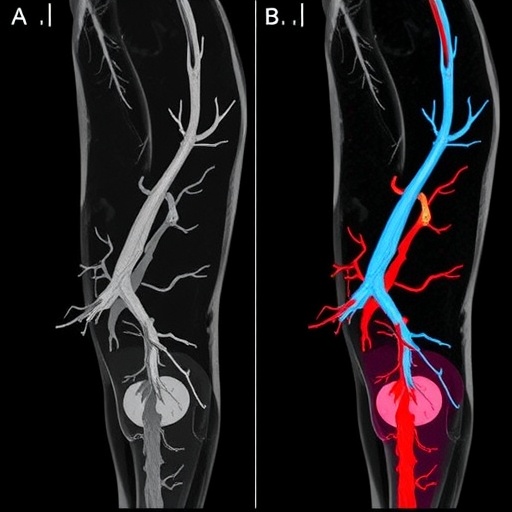In a groundbreaking study, researchers led by Gostev, Osipova, and Volkova have unveiled new insights into the biomechanical properties of femoropopliteal arteries—vital conduits in the circulatory system that play a crucial role in delivering oxygenated blood to the lower limbs. The investigation, conducted under physiological conditions, examined both healthy volunteers and patients who had undergone infrainguinal revascularisation. This innovative research is poised to enhance our understanding of vascular health and the underlying mechanisms that influence arterial function, potentially ushering in new therapeutic strategies for patients with arterial diseases.
The femoropopliteal arteries are instrumental in maintaining proper blood flow to the leg, but their biomechanical behavior can change due to various pathological conditions and surgical interventions. This study meticulously explored how the structural and functional aspects of these arteries differ between healthy individuals and those who have experienced vascular surgery. Consequently, it lays the groundwork for further research to ameliorate the long-term outcomes of revascularisation procedures, which are often complicated by changes in arterial properties.
Biomechanics is the study of the mechanical principles governing biological systems. When it comes to arteries, this field of research delves into the stiffness, elasticity, and overall structural integrity of blood vessels. Evaluating these properties is crucial because many cardiovascular diseases are linked to altered biomechanical profiles, which can lead to complications like restenosis or impaired blood flow. The authors adopted a comprehensive approach, employing advanced imaging techniques and mechanical testing of femoropopliteal arteries to determine the biomechanical parameters accurately.
Interestingly, one of the key findings of the paper highlights the stark contrast in the mechanical properties of the arteries between the two groups studied. Specifically, in healthy volunteers, the femoropopliteal arteries showcased greater elasticity, allowing for better adaptability to the pulsatile nature of the heart’s output. In contrast, patients who had undergone infrainguinal revascularisation demonstrated compromised elasticity, suggesting an increase in arterial stiffness. This alteration is particularly concerning as it may predispose patients to further cardiovascular events or complications post-surgery.
The research team took a sophisticated analytical approach, combining both experimental and computational methodologies. They used advanced imaging technologies to visualize arterial structure at a micro-level while applying mechanical stress to observe how the arteries respond under different conditions. This dual methodology allowed for a more nuanced understanding of how surgical interventions impact the biomechanical properties of femoropopliteal arteries, paving the way for enhanced patient-specific treatment plans in vascular surgery.
Additionally, the study sheds light on the implications of these biomechanical changes in the context of patient management. It raises critical questions about the long-term care for individuals who undergo arterial revascularisation. Given the alterations in arterial properties, the authors advocate for tailored rehabilitation programs that consider these changes in order to optimize recovery and minimize the risk of future complications. Achieving better clinical outcomes may hinge on a deeper understanding of how mechanical properties influence arterial health.
Moreover, the authors examined the cellular and molecular factors related to the changes observed in the arteries post-surgery. Such insights could be invaluable in developing targeted therapies aimed at improving arterial resilience. For instance, pharmacological interventions that enhance endothelial function could potentially reinstate some of the lost elastic properties, which would significantly improve patient quality of life. This nuanced angle underscores the importance of interdisciplinary research in bridging the gap between mechanical studies and clinical applications.
The implications of this study extend beyond isolated cases; they contribute to the broader discourse on vascular health and rehabilitation following surgical interventions. The findings serve to encourage a paradigm shift toward more personalized medicine in the realm of cardiovascular therapy, emphasizing the need for patient-centric approaches that account for the individual biochemical and biomechanical distinctions of arterial health. Such a shift could ultimately lower healthcare costs associated with complications from arterial diseases, which have become all too common in aging populations.
As one delves deeper into the results presented, it becomes evident that future research in this field will be crucial. It raises essential inquiries regarding optimal post-surgical monitoring strategies. For instance, should regular biomechanical assessments be standard for patients post-revascularisation? Continuous monitoring could facilitate early interventions when biomechanical properties appear to deviate from established norms, offering a proactive avenue for maintaining vascular health.
Furthermore, the potential for future advancements in the field is boundless. With the rise of artificial intelligence and machine learning, the ability to analyze large datasets related to biomechanical properties can provide unprecedented insights. Machine learning algorithms might be able to predict how individual patients will respond to various treatments based on their specific arterial characteristics, allowing for a truly personalized approach to vascular care in the future.
In summation, the research conducted by Gostev and colleagues represents a significant stride in our understanding of how revascularisation affects the biomechanical properties of femoropopliteal arteries. By focusing on patient-specific attributes and their implications for treatment plans, the study not only offers valuable insights into veterinary surgery outcomes but also invites further inquiry into the mechanisms underlying arterial health and disease. As we strive for improved patient care and outcomes, this research lays an essential foundation for future exploration in the biomechanics of vascular health, urging an evolution in both clinical practice and scientific inquiry.
These findings underscore the critical need for ongoing research into the biomechanics of arteries, particularly in response to surgical interventions. The revelations from this study prompt questions about the future of vascular surgery and rehabilitation. As additional studies build upon this foundational work, there exists an opportunity to refine surgical techniques, postoperative care, and ultimately enhance the longevity and quality of life for individuals healing from vascular procedures.
In essence, this work serves as a clarion call to the medical community—an invitation to bridge the gap between biomechanical research and clinical application, fostering advancements that can directly improve patient lives.
Subject of Research:
Biomechanical properties of femoropopliteal arteries in healthy volunteers and post-infrainguinal revascularisation patients.
Article Title:
Evaluation of the Biomechanical Properties of Femoropopliteal Arteries Under Physiological Conditions in Healthy Volunteers and Patients After Infrainguinal Revascularisation.
Article References:
Gostev, A., Osipova, O., Volkova, I. et al. Evaluation of the Biomechanical Properties of Femoropopliteal Arteries Under Physiological Conditions in Healthy Volunteers and Patients After Infrainguinal Revascularisation.
J. Med. Biol. Eng. (2025). https://doi.org/10.1007/s40846-025-00975-y
Image Credits:
AI Generated
DOI:
10.1007/s40846-025-00975-y
Keywords:
Biomechanical properties, femoropopliteal arteries, revascularisation, vascular health, elasticity, stiffness, personalized medicine, arterial function, rehabilitation, cardiovascular diseases.
Tags: arterial diseases and therapiesarterial function in patientsarterial stiffness and elasticitybiomechanical properties of arteriesblood flow to lower limbsfemoropopliteal artery biomechanicsinnovative vascular research techniqueslong-term effects of vascular surgeryphysiological conditions in vascular researchrevascularization outcomesstructural integrity of blood vesselsvascular health assessment





